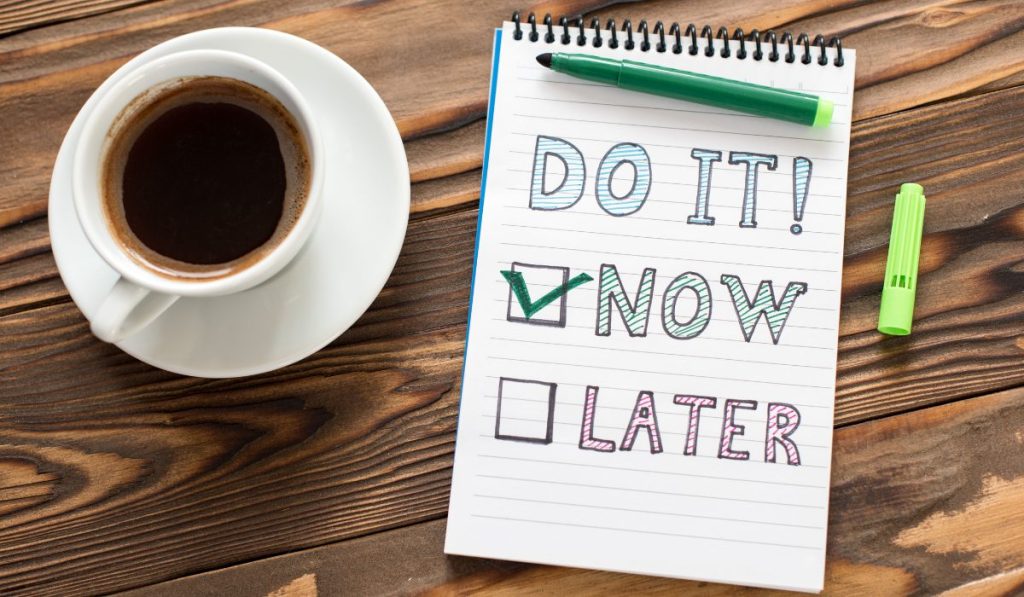Now that I have your attention, let’s start by banishing the word “laziness” from your self-concept altogether. We will allow procrastination to stay, with the caveat that there are many flavors of procrastination, many of which serve important functions. For example, we might find ourselves putting off writing a pointed email until we have cooled off from a meltdown. This is a topic for another article. In the present article, we are talking about increasing productivity on our regular task list, and being more efficient with our time manglement, er, I mean management. Building systems that help us to function optimally is a crucial skill for business leaders, especially those who are neurodiverse. Professionals who face difficulties managing their time and energy can come up with creative tactics to stay on track and make progress on daily tasks and bigger projects.
In this blog post, we’ll uncover common blockages to productivity while outlining concrete steps to overcome these challenges, as well as strategies for boosting focus and efficiency. We will discuss how to identify specific triggers and present techniques to try out.
We will also cover how to create an external environment that’s conducive to staying focused by minimizing distractions and an internal environment that bolsters our capacity by prioritizing self care.
Are you ready to let go of beating yourself up for being “lazy” (You are not lazy!) and design a pathway away from procrastination and towards achieving sustainable momentum towards your goals?
Identifying the Causes of “Laziness” and Procrastination
It is important to understand that laziness and procrastination are two distinct concepts with different causes. For example, emotions such as anxiety and dread of not succeeding may be the underlying reasons for procrastination, as opposed to “laziness,” which is often perceived as an inherent human trait.
The truth is, most people have moments of low motivation or lack of energy, and being neurodivergent certainly increases when and how long this happens for me and my clients. Labeling these instances as “laziness” is always misleading and actually blocks productivity. But we can identify and address the root causes of procrastination and develop strategies to overcome them.
Common Triggers of Procrastination
Identifying specific situations or types of tasks that regularly lead to putting things off can help you develop strategies for overcoming these challenges. Some common triggers include feeling overwhelmed by large projects, perfectionism, negative feelings, or negative self-talk.
Prioritizing Tasks to Overcome Procrastination
Not surprisingly, boosting productivity requires prioritizing tasks based on their importance. This is a great way to help you focus on what matters most, which can help with reducing delays and inaction.
Effective Task Prioritization Techniques
Task prioritization techniques can be helpful for managing your workload more efficiently. There are countless tools out there to try. Perhaps you’ve already gotten excited about a few, only to lose interest once the novelty wears off. For many of my clients, there isn’t a one-size-fits-all tool. Personally, many strategies and systems send me into instant overwhelm. This can be quite disheartening. What has worked for me, and many of my clients, is starting with what already is working. It might not seem like it, but there are things that are working for you right now! Otherwise, you wouldn’t be where you are at. Here’s an example: many of my ADHD clients find deadlines to be quite effective in getting that dopamine level ideal for productivity. Indeed, this is a tool that can be leveraged with intention to get results. (Protip: It’s always good to add a little extra time before waiting until the last minute to do something because time blindness is a real thing.)
At the same time, researching some of the plethora of tools available can stimulate new ideas to try out. I use a handful of ideas from the book Getting Things Done by David Allen to this day. Here is an overview of some of the strategies popular today.
Here are a few techniques that can help you on your journey to getting more done:
- Eisenhower Matrix: This involves categorizing a particular task by urgency and importance. This makes it much easier to determine which ones to tackle first.
- Ivy Lee Method: With its simple approach of listing and tackling 6 tasks per day in order of importance, this method can help reduce procrastination by providing a clear and manageable roadmap for daily productivity. This focused approach minimizes confusion on how to spend your time and helps keep you accountable. I use a similar technique except that I try to limit my focus to 3 tasks to ensure that I experience myself as successful at the end of each day. I also tend to do the quickest, funnest, and easiest tasks first. Crossing something off my list kickstarts my productivity, giving me precious momentum to handle more difficult (for me) tasks, like responding to emails or worse, returning phone calls!
- ABCDE Method: For this method, you’ll assign a letter grade to each challenging task based on priority level. By categorizing tasks based on their importance and deadlines, this method encourages decisive action and streamlines your workflow. Again, I use a simple modification of this approach. I draw a star next to anything super important that I plan on tackling in the near future. If something is super important, I throw it on my Google Calendar in a time slot where I am likely to be able to do it. If I reach that date and it’s not a good time, I either move the task out to another time slot, or fail to do that and forget the task ever existed. Thankfully, I only do that about once every 3 months. It’s so painful when I do that the lesson sticks that long! Pretty good, right?
Establish Clear Achievable Goals
Breaking down larger projects into smaller goals with specific deadlines can help maintain motivation. It provides a sense of accomplishment as you tackle each small step. In my executive coaching sessions, we always finish with 3 Action Steps. These usually include one or two laser focused next steps to bigger goals. We identify the ridiculously easy next step to move things forward. This is especially effective when one is procrastinating. Either being held accountable to this action will help my client get unstuck, or it will reveal that there is some other obstacle, such as not having the right tool to complete the task. Getting the right tool, such as jogging shoes to start a running habit, does a lot to enable the next step.
Related: How Can I Make My Workplace More Trans Inclusive?

Strategies for Enhanced Focus and Productivity
Combatting Overwhelm
Feeling overwhelmed by all the things? Here are some tools to try. Honestly, some of my favorite tools can feel a bit hokey or contrived. But because I have tried them, and found them to be effective; and because I’ve suggested my clients try them and they have also found them effective, I share them with you now. Try incorporating morning meditation and positive affirmations to set the tone for the day.
I think of meditation as sanctioned rest. Instead of sitting in my armchair feeling guilty for doing nothing, I can claim with a little self-indulgent righteousness that I am, in fact, meditating. And yes, I meditate in my armchair, because it’s comfortable for me. I will never meditate sitting erect, letting my spine support my body to ensure that I stay alert. Hypotonia makes sitting in any one position for any length of time excruciating for me and many other neurodiverse people. So I sit in my armchair and simply notice where my thoughts go without any pressure or expectation. I don’t try to count breaths because that hurts both my autism and my ADHD. I just notice things such as sounds or sensations in my body. And then I notice as soon as I realize that I forgot to notice things, and gently get back to it. I definitely don’t aim for a quiet brain, because seriously! I’m trying to feel successful here. Also, some of my best ideas enter my mind during meditation. I keep a journal handy for just such an occasion. I’ll write more about meditation in a future post.
Let’s talk about positive affirmations. First, I want to reassure you that I am not one of those people who places particular importance on “making it a great day”. I despise the whole concept that one can choose their every mood, or that it is even important to be happy and optimistic. I’d much rather we feel a range of emotions that make sense for us at any given moment, and that we have enough access to our feels to provide empathic responses without getting triggered. Affirmations are like thought tapes that we can plug in when having thoughts that are annoying or not serving us well. It would be nice to turn off all nonessential thinking, but when your brain hasn’t put much effort into neural pruning and every thought connects to a million other thoughts without any sense of prioritization, quieting the brain seems like a lot to ask. So, if the thoughts I am getting access to are ones like “I am never enough,” while that may or may not be true, I’ll surely do a better job by not thinking it. So I plug in an affirmation such as “I am doing my best and it is enough.” It’s not a bad thought to have, really.
These practices can be surprisingly helpful in preparing your brain to engage more enthusiastically, or at least less begrudgingly.
Time Management
Another suggestion is to use the Pomodoro Technique to maximize productivity and stop procrastination. To do this, you’ll create work time limits (usually 25 minutes) followed by brief breaks (usually 5 minutes). This approach allows for mental rest between sessions while maintaining concentration. I have yet to test this approach as I am resistant to stopping a project once I have finally started it! Shifting gears can be particularly jarring for neurodiverse people. I honestly can’t imagine working for 25 minutes, stopping for 5, then starting again. I can imagine working for 25, and then working for another 3 hours totally forgetting to eat and completely dissociating from the needs of my bladder. I can imagine working for 25 minutes, then stopping, and then dropping the task for another couple of weeks before picking it back up. Still, I have some good friends in the Immersed VR co-working app that have scheduled Pomodoro groups and my FOMO might just get me to try it!
Creating an Environment Conducive to Productivity
Making a distraction-free space can also help with workflow. When you’re intending to be productive, it’s a good idea to turn off notifications on electronic devices and get away from noises: visual, audio, emotional, and otherwise, to help you focus.
Tips for Minimizing Distractions Within Your Workspace
Here are a few tips to minimize distractions in your workspace:
- Organize your desk: When I say “organize your desk” I do not mean to hide everything from yourself. For many of us, starting a filing system is a bad idea. We may as well just burn all of our stuff in a trash can fire. We will forget that any of those files ever existed anyway. One thing that has worked for me is to sort my tangible clutter into three piles: Urgent (this week), Soon (in the next week or two), and Go Through This Stack Again Later (not enough info or urgency to set a deadline yet). I resist dicing to toss anything. Deciding on each sheet of paper if I really need to keep it around or not can take up too much time, bandwidth, and emotional energy.
- Use noise-canceling headphones: Block out distracting noises with noise-canceling headphones. This small step can help you concentrate on your work and be more productive. Plus, they are really great for grocery shopping.
- Set specific times for checking emails or social media: Constantly checking your email or social media can be a major distraction. Instead, set specific times to check them and keep your notifications on silent or “do not disturb” in the meantime. Yeah. I can’t see myself doing this one, either. I have modified this suggestion in a way that seems to work better for me. I check each notification because–curiosity. But I pretend that I haven’t. That is, I take no action on anything incoming. I simply look at the notification, and then continue what I’m doing. Am I afraid that I might forget something? I absolutely will. That’s why I do a sweep of all the regular inputs, Email, Instagram, Messenger, Messages, LinkedIn, Facebook, WhatsApp, Discord, when I’m ready to take action on such things. I have to be in the right mood, anyway.
Importance of Maintaining Healthy Lifestyle Habits
There are different ways to improve focus and energy levels, such as regular exercise, proper nutrition, and getting sufficient sleep. Consider incorporating activities like yoga or meditation into your daily routine to further enhance mental clarity. A good way to get ideas is to ask your friends and colleagues what they do to stay calm and present. Or I suppose you could pick a coworker who isn’t calm and figure out what to avoid.
Also, try to avoid bad habits such as eating junk food or other habits that you know will decrease your vitality and natural energy levels. We all have these little things that we know aren’t the greatest and other things we know we probably ought to do for our health. Instead of expecting to change everything and getting overwhelmed, pick one little thing to reduce and another little thing to begin. I can stop buying potato chips easily enough, and I can start stretching a little bit every day. When stretching becomes a habit, I can add something new to my healthy lifestyle plan.
Related: 4 Ways to Embrace Neurodiversity in the Workplace

Addressing Emotional Impacts Associated With Procrastination
Procrastination often stems from emotional factors such as fear of failure, anxiety, or self-doubt. The best way to overcome these emotions and boost productivity is to develop healthy coping mechanisms. One effective strategy is practicing cognitive behavioral techniques, which can help reframe negative thoughts and beliefs.
Working with a licensed mental health professional such as a psychotherapist or a productivity coach such as our experienced coaches at Flanagan Leadership Group can help individuals identify and overcome self-defeating patterns, ultimately leading to improved productivity and a healthier mindset. Our experts provide personalized guidance and support tailored to each person’s unique challenges and goals, empowering them to break free from the barriers of procrastination and unlock their full potential.
Click here to schedule a free consultation to see if personal coaching can help you overcome procrastination once and for all.
Healthy Coping Mechanisms
- Mindfulness: Practicing mindfulness helps you stay present in the moment and reduces stress associated with chronic procrastination. (source)
- Self-compassion: Being kind to yourself when facing setbacks can reduce feelings of guilt or shame that contribute to an endless cycle of procrastination. (source)
- Social support: Connecting with others who share similar struggles allows for mutual encouragement. In addition, they act as accountability partners in overcoming challenges related to procrastination.
FAQs About How to Overcome Laziness and Procrastination
How to Overcome Laziness and Procrastination
Identify root causes, prioritize important tasks, and implement productivity strategies. Also, create a conducive environment, address emotional impacts, and try the Pomodoro Technique. Further, try to meditate, use positive affirmations, and maintain healthy lifestyle habits.
Root Causes of Laziness and Procrastination
Fear of failure or success, perfectionism, lack of motivation or interest, low self-confidence, poor time management skills, and overwhelming workload.
Overcoming Procrastination When Reading Articles
Create specific goals, schedule dedicated time slots, prioritize important articles, and use speed-reading tools.
How to Overcome Extreme Laziness
Analyze underlying reasons, break an unpleasant task into smaller steps, set achievable goals and deadlines, and increase dopamine levels through exercise, diet, or other motivating activities.
Related: What is Neurodiversity?
Conclusion
So, how can you overcome laziness and procrastination?
Start by taking action towards your big goals.
Here’s a breakdown of our tips for overcoming laziness and procrastination:
- In the first place, try to identify the root cause of your procrastination and address it head-on.
- Make a to-do list, set goals, and prioritize tasks based on importance and urgency.
- Use focus-enhancing techniques such as the Pomodoro technique or time-blocking.
- Another important step is to create a conducive environment by eliminating distractions and setting up a comfortable workspace.
- Address the emotional impacts of procrastination by practicing self-compassion and positive self-talk.
- Stay motivated by celebrating small wins and tracking progress towards your goals.
- Ask for professional help or talk to a family member.
Banish procrastination and laziness using these strategies on a daily basis. So, start implementing these healthy coping mechanisms today and take control of your productivity.
In conclusion, overcoming procrastination is a crucial step towards achieving success and personal growth. By using these strategies and working with a licensed mental health professional or a productivity coach like the experienced coaches at Flanagan Leadership Group, you can effectively address self-defeating patterns and unlock your full potential.
Our experts offer personalized guidance and support tailored to your unique challenges and goals, empowering you to break free from the barriers of procrastination.
Don’t let procrastination hold you back any longer.
Click here to schedule a free consultation and discover how personal coaching can help you conquer procrastination for good.


